Here is an explanation of some of the more commonly used beads in native American jewelry and crafts.
Chevron Beads
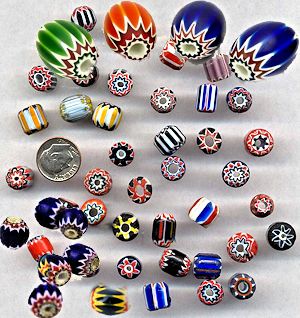
Chevron Beads
Chevron beads are really special glass beads. The first specimens of this type were created by glass bead makers in Venice and Murano, Italy, toward the end of the 14th century. They may also be referred to as rosetta beads, or star beads.
With their glossy striped aesthetics, and ellipsoid shapes, they are beautifully versatile for all kinds of stringing purposes. They are also highly collectible, since they are sourced directly from Africa, and bear a trade history in excess of a century. Interestingly, there is also a manner by which we can date them…More about Chevron beads.
Crow Beads
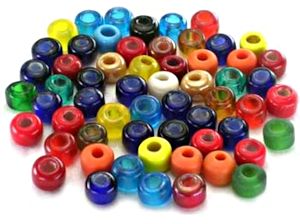
Crow Beads
Crow beads are a glass bead that is often used in native American crafts. These have the same round shape but usually range from about 6mm – 9mm with 9mm being the standard crow bead. The 6mm crow beads are usually referred to as Mini Crow Beads.
Oddly, these beads are sometimes sized with numbers like 31/0, 32/0 etc. This method is just too confusing (because the general rule is the larger the number, the smaller the bead, and this breaks the rule). To make matters worse, some crafts stores call these “pony beads,” which is actually a much smaller bead. These beads are usually strung and used for necklaces, chokers, breastplates, etc. Shop for Crow beads.
Charlottes
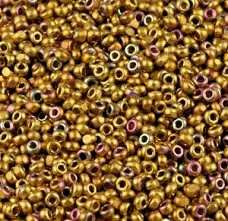
Charlotte Beads
A charlotte bead is a size 13/0 cut seed bead. A cut seed bead is a bead in which flat surfaces have been cut into the bead. This makes the bead reflect light and sparkle a bit. Very popular for fan handles, small bags, or anywhere an elegant touch is needed. A very popular bead.
Elliot Greene of New York, an importer of Czech glass beads, states the name was attributed to his daughter.
Note that all charlottes are cut beads, but not all cut beads are charlottes. They must be a size 13/0 cut. …More about Charlotte Cut Seed Beads
Fire Polished Beads
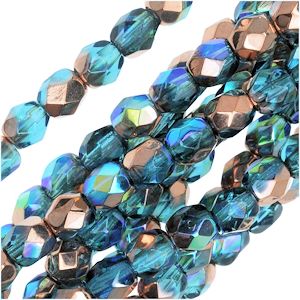
Fire Polished Beads
In the Native American trade, the term fire polished beads always refers to a round, facetted bead which is typically 6mm or 8mm in diameter (although smaller and larger sizes exist). Fire polished actually refers to a method used in finishing beads and has nothing to do with the size or shape. But it always refers to a round bead.
These beads are most commonly used in making women’s Plains-style breastplates but also occur in chokers, straight dance bandoleers, and many other projects. Note that while the bead may be large, the holes are quite small. You’ll need to use some type of bead string, imitation sinew, or something similar to string these beads. Forget using leather thong of any type.
French Brass Beads
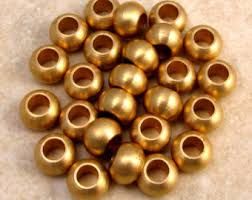
French Brass Beads
French brass beads are used to describe solid brass beads which were commonly used in the Native American trade. It is frequently seen in breastplates, chokers, and similar items. The normal size is about 8mm but smaller sizes also exist. Note that the term “French” is somewhat generic. Some beads are made in France, but most are made in Asia or India today. This bead has a large hole and can easily be strung using leather thong.
Lantern Beads
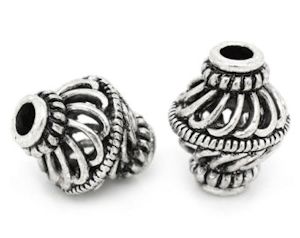
Lantern Beads
Lantern beads are an interesting octagon-shaped tube bead being made in the Czech Republic. As far as we know, this is a relatively new bead and has no historical use in Native American crafts. However, they are quite flashy and pretty cool. Use them wherever a fire polished bead would be used. These beads have small holes like the fire polished beads.
Old-Time or Hollow Brass Beads
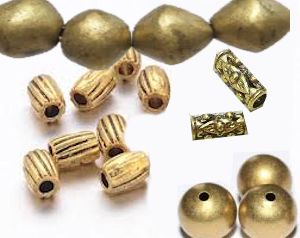
Old Time Brass Beads
Old-time brass beads are generally tubular or barrel shaped and are typically hollow, thus they are also referred to as Hollow Brass Beads. You might ask how a bead can be solid or hollow. Aren’t all beads hollow? They all have holes, don’t they? Well, it’s kind of hard to describe.
Basically, the French Brass Beads are quite heavy while the Old-Time Brass Beads are quite light. Note that while we (and many other vendors) sell beads which are called “old-time brass beads,” none of these are an exact reproduction of the old beads. Some are pretty close, though. These beads are typically about 7-8mm and are used for the same purposes as the solid French Brass Beads. They tend to have smaller holes than the French Brass beads, but you can still get them on a leather fringe with some practice and patience. …Shop for Old Time Brass Beads.
Pony Beads
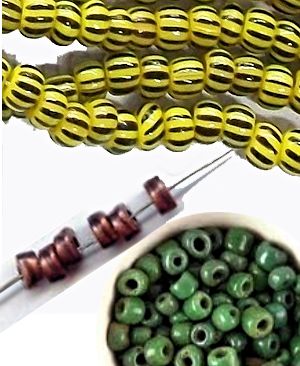
Reproductions of antique style pony beads
Pony beads are basically a large seed bead. These beads were introduced to the Native American trade before seed beads (possibly as early as 1675). Some sources say these beads got their name because they were transported by traders on ponies (but other sources dispute this).
Pony beads are typically found in sizes 5/0 and 8/0. Note that some craft stores call these “E” beads. The 8/0 is the most commonly used size. These beads are used for the same purposes as seed beads but the work is obviously not as fine.
Many stores also erroneously call plastic crow beads “pony beads.” They are the same size as glass crow beads, but are made of plastic, which is more economical for kid’s crafts, as they are very inexpensive. Shop for plastic pony beads.
Rocailes
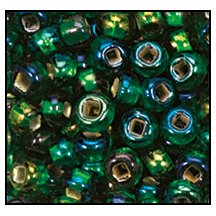
Rocailles
Pronounced “roh kai,” rocailes were historically round, silver-lined seed beads with square holes. Today the term is also applied to all round seed beads of the type that most people readily associate with seed beading. These modern beads normally have round holes, but Toho has recently re-introduced Rocailles with square holes to provide greater accuracy when placing them in designs.
Rondelle Beads
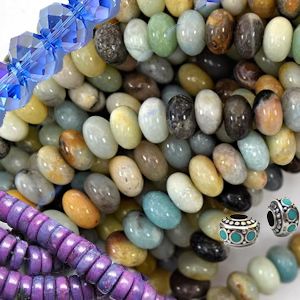
Rondelles
A bead that is rondelle shaped is round with flattened or faceted ends. It is usually used as a spacer between other beads.
Sand Cast Beads
Sand Cast Beads, also known as Ghana Sand Cast, are also commonly called Powder Glass Beads. The technique for creating this style of bead started in Ghana during the 16th century. Very fine pieces of crushed glass are held together with a binding material such as saliva or gum arabic and spread over a grass stem or a bottle glass core. After cooking in the oven, the beads are rolled in other small pieces of glass to create patterns.
Seed Beads
A very small bead about the size of bird seed. These are primarily used for covering the surface of an object (a bag, moccasins, etc). They range in size from 10/0 to about 22/0. The larger the number, the smaller the size. A 10/0 is often used by beginners. Most people work in 11/0 or 12/0.
Beads smaller than 13/0 are rarely made today (some 14/0 are still in production). The very small sizes will make you go blind (just kidding but they are hard to find and work with). Seed beads were introduced after 1840. Note that seed beads are sometimes called rocailles…More about Seed Beads. Shop for seed beads.
Tile Beads
Tile beads are typically a 4-6mm tube shaped bead. These were most commonly used to decorate Plateau women’s dresses but are also used to make drops on bags and other projects. They are also used as spacers on bone chokers and other jewelry.
White Hearts
White Hearts is a term used to describe a bead which has a white lining. The bead is actually a transparent glass but the white lining causes it to have somewhat translucent qualities.
White hearts come in many different sizes including seed beads, pony beads, and crow beads. White hearts have always been a prized bead.
Today, one of the “holy grails” in the old-time seed bead market is trying to make (or find) the perfect shade of red white heart seed bead. This color was commonly used by the Plains Indians and has proven to be very difficult to reproduce. In fact, one of the main indicators used to authenticate antique beadwork is the color of white heart used (as well as other colors and many other factors).
Note that white hearts are sometimes called cornaline d’ Aleppo beads. White hearts are being made in France in most sizes and in crow bead sizes in the Czech Republic. India is also making them, but a different manufacturing technique is being used which makes them a little clunky looking (at least in our opinion).
